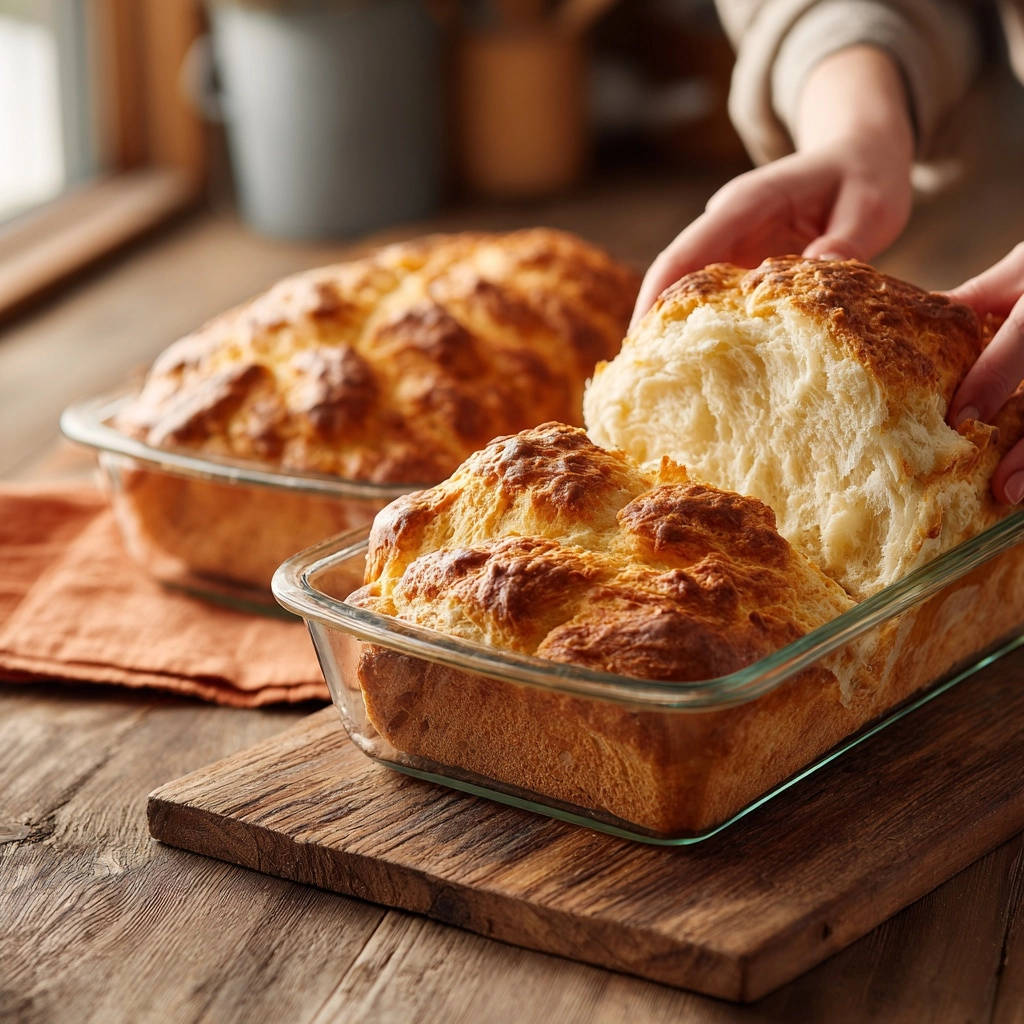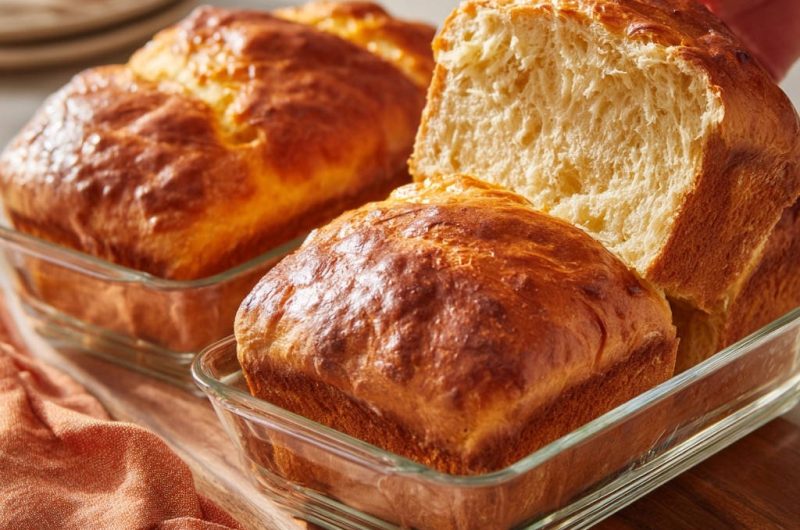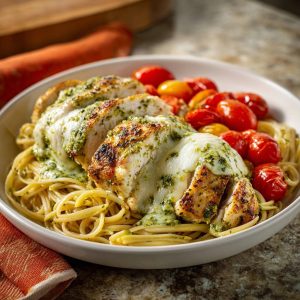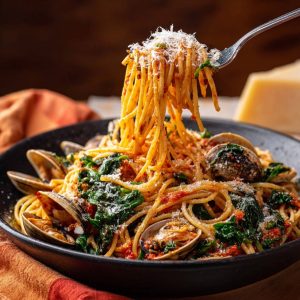I remember countless attempts at baking that elusive, incredibly soft bread, often ending up with a denser crumb than I desired. Then I discovered the Tangzhong method, and it truly revolutionized my bread baking. This technique ensures every single Golden Fluffy Loaf emerges unbelievably light, tender, and moist, making those past struggles a distant memory.
This recipe isn’t just about baking bread; it’s about crafting a truly exceptional experience for anyone craving that perfect, melt-in-your-mouth texture. It’s the reliable secret to achieving bakery-quality results right in your own kitchen.
Why This Recipe is Your New Favorite Golden Fluffy Loaf
The “Never Dense” Promise: Achieving That Airy Crumb
Forget dry, heavy bread. This Golden Fluffy Loaf recipe specifically tackles the common issue of density, delivering a consistently light and airy crumb.
The secret lies in the unique preparation method, which locks in moisture and creates an open, delicate structure.
Melt-in-Your-Mouth Softness, Every Single Time
Prepare for an unparalleled texture experience. Each slice of this loaf is exceptionally tender, practically dissolving as you eat it.
The method ensures your bread stays soft for days, a true testament to its superior quality.
Beyond Basic: The Magic of Tangzhong for Superior Texture
The Tangzhong method is the cornerstone of this recipe’s success. It involves pre-cooking a small portion of flour and water into a paste.
This gelatinizes the starch, allowing the flour to absorb more liquid. The result is a dough that retains incredible moisture, leading to an incredibly soft, fluffy, and fresh loaf for longer.
Gathering Your Ingredients: The Building Blocks of a Fluffy Masterpiece
For the Tangzhong: A Simple Yet Powerful Starter
Just two tablespoons of all-purpose flour and half a cup of water create this magical starter.
This paste is fundamental for trapping moisture and enhancing the bread’s overall texture, providing that signature fluffiness.
Dough Essentials: Flour, Sweetness, and Leavening
All-purpose flour forms the structural base, while granulated sugar adds a subtle sweetness and aids in crust browning.
Salt balances the flavors and regulates yeast activity, and instant dry yeast ensures a vigorous and consistent rise.
Enriching Agents: Milk, Egg, and Butter’s Role
Warm milk contributes to a richer flavor and helps activate the yeast effectively. A room temperature large egg adds moisture, tenderness, and a lovely golden hue to the crumb.
Softened unsalted butter is crucial for an incredibly tender texture and adds a luxurious richness to your Golden Fluffy Loaf.
The Golden Finish: Our Simple Egg Wash
A simple combination of one large egg and one tablespoon of milk creates the perfect egg wash.
This wash is brushed on top just before baking, providing that irresistible golden-brown crust and a beautiful sheen.
Essential Tools for Your Golden Fluffy Loaf Adventure
Small Saucepan & Whisk: Essential for preparing the Tangzhong method correctly, ensuring a smooth, lump-free paste.
Large Mixing Bowls: You’ll need one for combining dry ingredients and another for the wet, plus a lightly oiled bowl for the first rise.
Stand Mixer (with Dough Hook) OR Strong Hands: A stand mixer makes kneading much easier, but thorough hand kneading is just as effective for developing the crucial gluten structure.
Lightly Greased Loaf Pans (8×4 inch recommended): These are perfect for shaping and baking two beautifully formed loaves.
Wire Rack: Crucial for cooling the loaves evenly after baking, preventing a soggy bottom and maintaining their airy structure.
Instant-Read Thermometer: Invaluable for accurately checking the temperature of your warm milk and ensuring your baked loaf is perfectly cooked through.
Plastic Wrap or Clean Kitchen Towels: Essential for covering the dough during both proofing stages, creating a warm, moist environment for rising.
Crafting Your Golden Fluffy Loaf: A Step-by-Step Journey to Perfection
Mastering the Tangzhong (The Foundation of Fluff)
In a small saucepan, whisk together 2 tablespoons of all-purpose flour and 1/2 cup of water until completely smooth. Cook this mixture over medium-low heat, stirring constantly, until it transforms into a thick, paste-like consistency, similar to wallpaper paste.
This process typically takes about 3-5 minutes. Immediately transfer the Tangzhong to a small bowl and allow it to cool completely to room temperature before incorporating it into your dough. This critical step pre-gelatinizes the starch, which is the secret to an incredibly soft, moist crumb that keeps your Golden Fluffy Loaf fresh and tender for days.
Uniting Your Dry and Wet Elements
First, combine the 2 1/2 cups of all-purpose flour, granulated sugar, salt, and instant dry yeast in a large mixing bowl. Whisk these dry ingredients thoroughly to ensure even distribution.
In a separate medium bowl, whisk together the warm milk and the room temperature large egg. Now, add your completely cooled Tangzhong to this wet mixture and whisk until everything is smooth and fully incorporated.
The Art of Kneading for Ultimate Elasticity (The Windowpane Test)
Pour the wet ingredient mixture into the dry ingredients and mix with a spoon or your hands until a shaggy dough forms. Turn the dough out onto a lightly floured surface.
Knead the dough for approximately 8-10 minutes until it begins to feel somewhat smooth and elastic. Now, gradually add the softened butter, one cube at a time, ensuring each addition is fully incorporated into the dough before adding the next.
Continue kneading for another 10-15 minutes until the dough is smooth, highly elastic, and passes the windowpane test. To perform the windowpane test, gently stretch a small piece of dough: it should stretch thin enough to see light through it without tearing. This extensive kneading is paramount for developing the strong gluten structure necessary for that signature Golden Fluffy Loaf texture.
First Rise: Letting the Magic Happen
Lightly grease a clean bowl with a small amount of oil. Place your meticulously kneaded dough into the bowl, turning it once to ensure it’s evenly coated.
Cover the bowl securely with plastic wrap or a clean kitchen towel. Allow the dough to rise in a warm, draft-free place for 1 to 1 1/2 hours, or until it has visibly doubled in size. A successful first rise is crucial for a light and airy result.
Shaping Your Loaves for an Elegant Presentation
Gently punch down the risen dough to release the accumulated air. Transfer the dough to a lightly floured surface and divide it into two equal portions for your two loaves.
For each portion, divide it further into three smaller, equal pieces. Roll each small piece into a smooth ball. Arrange three dough balls side-by-side in each lightly greased small loaf pan (approximately 8×4 inches works perfectly).
The All-Important Second Rise
Loosely cover the loaf pans with plastic wrap or a clean kitchen towel. Return them to a warm, draft-free place for another 45-60 minutes.
The loaves should nearly double in size and appear noticeably puffy. This second rise contributes significantly to the final volume and delicate crumb of your Golden Fluffy Loaf.
Preheat & Prepare: Setting the Stage for Baking
While your loaves are undergoing their second rise, preheat your oven to 350°F (175°C). This ensures the oven is at the correct temperature the moment your loaves are ready to bake.
In a small bowl, whisk together the remaining egg and tablespoon of milk for your egg wash. Have this ready for a beautiful golden crust.
Baking to Golden Perfection
Once the loaves have completed their second rise, gently brush the tops with the prepared egg wash. This creates that desirable golden-brown finish.
Bake the loaves for 25-30 minutes, or until the tops are beautifully golden brown and an instant-read thermometer inserted into the center reads between 200-205°F (93-96°C). If the tops begin to brown too quickly, you can loosely tent them with aluminum foil to prevent over-browning while the interior finishes baking.
The Cool Down: Patience for Peak Fluffiness
Carefully remove the baked loaves from the oven. Allow them to cool in their pans for about 5-10 minutes.
Then, gently transfer the loaves to a wire rack to cool completely. While it’s tempting to slice into a warm loaf, letting them cool fully allows the internal structure to set, ensuring maximum fluffiness and preventing a gummy texture.
Pro Baker Secrets: Elevate Your Golden Fluffy Loaf Game
Temperature Matters: Proofing Pointers. A consistent warm environment (around 75-80°F / 24-27°C) is ideal for yeast activity. To achieve this, you can proof dough in a slightly warmed, turned-off oven or near a sunny window, always avoiding cold drafts that can inhibit rising.
Don’t Rush the Kneading: Gluten Development is Key. The extensive kneading in this recipe is not optional; it’s crucial for developing a strong gluten network. This elasticity allows the dough to trap gasses during proofing, resulting in a truly light and airy crumb, so keep kneading until that windowpane test is successful!
The Role of Room Temperature Ingredients. Using room temperature milk, egg, and softened butter ensures they integrate smoothly into the dough. Cold ingredients can shock the yeast and hinder gluten development, leading to a less cohesive and less fluffy loaf.
How to Check for Doneness (Beyond Just Color). While a golden crust is appealing, an internal temperature of 200-205°F (93-96°C) guarantees your Golden Fluffy Loaf is fully baked. This prevents a gummy interior and ensures the bread is cooked through, maximizing its keeping quality.
Adjusting for Humidity and Altitude. In high humidity, you might need slightly more flour; in dry climates, a bit less. At higher altitudes, yeast can be more active, so consider slightly reducing the yeast or shortening proofing times to prevent over-proofing and a crumbly texture.
Troubleshooting Common Golden Fluffy Loaf Challenges
Why Is My Loaf Dense?
A dense loaf often results from under-kneading, which means the gluten structure hasn’t fully developed. Insufficient proofing, where the yeast hasn’t had enough time to create air pockets, can also be a culprit.
Ensure you knead until the windowpane test is passed and allow the dough to double in size for both rises, adjusting proofing time based on your environment’s temperature.
My Dough Isn’t Rising
Inactive yeast is a common cause; ensure your instant dry yeast is fresh. Your warm milk might also be too cold (below 105°F/40°C) or too hot (above 115°F/46°C), either inhibiting or killing the yeast.
Confirm your proofing environment is warm and draft-free, as cold conditions can significantly slow or stop yeast activity.
Loaf is Too Dry or Crumbly
Overbaking is a primary reason for a dry or crumbly loaf. Always use an instant-read thermometer to ensure the bread reaches the correct internal temperature of 200-205°F (93-96°C) without exceeding it.
Too little moisture in the dough, perhaps from inaccurate measuring, can also contribute to dryness, so double-check your ingredient quantities.
Uneven Browning or Sticky Top
Uneven browning can indicate oven hot spots; rotating your loaf pans halfway through baking can help. A sticky top often means the loaf hasn’t baked long enough, and residual moisture is still present.
Ensure you’re baking to the correct internal temperature, not just relying on visual cues. If the top is browning too fast, tenting with foil is an easy fix.
Serving Suggestions & Storage for Your Delicious Creation
Enjoying Your Golden Fluffy Loaf: Versatile Ideas
This Golden Fluffy Loaf is exceptional on its own, simply sliced and spread with a good quality butter. For a sweet treat, try it toasted with homemade jam or a drizzle of honey.
It also makes incredible sandwiches, elevating everyday lunches to something special. Consider serving alongside savory dishes like a hearty stew or even as a base for a gourmet grilled cheese.
For a perfect pairing with a comforting meal, consider making a side of fluffy mashed potatoes.
Storing for Lasting Freshness
To keep your Golden Fluffy Loaf at its best, store it at room temperature in an airtight bread bag or container. It will remain wonderfully soft for 3-4 days.
For longer storage, slice the cooled loaf and freeze the slices in a freezer-safe bag for up to 2-3 months. Thaw individual slices as needed for quick enjoyment.
Can You Make it Ahead?
Absolutely! You can prepare the dough up to the end of the first rise, then punch it down, shape it, and place it in the loaf pans. Cover tightly with plastic wrap and refrigerate overnight.
The next morning, let the loaves come to room temperature and complete their second rise before baking as usual. This can also be adapted if you’re exploring other bread recipes like our simple sandwich bread.
Frequently Asked Questions About This Golden Fluffy Loaf
Can I Use a Stand Mixer for Kneading?
Yes, a stand mixer with a dough hook is highly recommended for this recipe. It makes the extensive kneading process much easier and more efficient, ensuring proper gluten development without tiring your arms.
Follow the same timings and visual cues (like the windowpane test) as you would for hand kneading.
Is Tangzhong Really Necessary?
While you can make bread without Tangzhong, it is the key ingredient that gives this Golden Fluffy Loaf its unique, unparalleled softness and moisture.
Omitting it will result in a good loaf, but it won’t have the same signature airy, melt-in-your-mouth texture that makes this recipe so special.
Can I Make This Gluten-Free?
Unfortunately, achieving the exact same “Golden Fluffy Loaf” texture with gluten-free flours can be challenging due to the vital role of gluten in bread structure. Gluten-free flours behave differently and may require significant recipe adjustments and alternative binding agents.
While you can certainly bake gluten-free bread, this particular recipe relies heavily on gluten development for its signature fluffiness.
What If I Don’t Have Instant Yeast?
You can substitute active dry yeast for instant dry yeast in this recipe. Just make sure to activate it first.
Combine the active dry yeast with the warm milk (and a pinch of sugar, if desired) and let it sit for 5-10 minutes until foamy before adding it to your other wet ingredients.
How Can I Tell When the Dough Has Proofed Enough?
For both rises, the dough should visually double in size and appear noticeably puffy. You can also perform the “poke test”: gently press a floured finger into the dough.
If the indentation slowly springs back halfway, it’s perfectly proofed. If it springs back immediately, it needs more time; if it collapses, it’s over-proofed.
Share Your Golden Fluffy Loaf Masterpiece!
Baking this Golden Fluffy Loaf is more than just following a recipe; it’s a rewarding experience that fills your home with the comforting aroma of fresh bread and culminates in a truly spectacular result. The pure joy of slicing into that incredibly soft, golden crumb you made yourself is unmatched.
I encourage you to try this recipe, embrace the magic of Tangzhong, and share your baking triumphs. We love seeing your creations! Leave a comment below with your feedback, tips, or even a photo of your beautiful Golden Fluffy Loaf.
Golden Fluffy Loaf
Course: BreadCuisine: American CuisineDifficulty: easy2
small loaves30
hours25
minutesAmerican Cuisine
Ingredients
For the Tangzhong:
2 tablespoons all-purpose flour
1/2 cup water
For the Dough:
2 1/2 cups all-purpose flour, plus more for dusting
1/4 cup granulated sugar
1 teaspoon salt
1 tablespoon instant dry yeast
1/2 cup warm milk (about 105-115°F)
1 large egg, room temperature
4 tablespoons unsalted butter, softened and cubed
For Egg Wash:
1 large egg
1 tablespoon milk
Directions
- Prepare the Tangzhong: In a small saucepan, whisk together the 2 tablespoons all-purpose flour and 1/2 cup water until smooth. Cook over medium-low heat, stirring constantly, until the mixture thickens to a paste-like consistency, resembling wallpaper paste. This should take about 3-5 minutes. Remove from heat and transfer the tangzhong to a small bowl. Let it cool completely to room temperature before using. This crucial step is the secret to an incredibly soft and moist crumb, ensuring your bread stays fluffy.
- Combine Dry Ingredients: In a large mixing bowl, combine the 2 1/2 cups all-purpose flour, granulated sugar, salt, and instant dry yeast. Whisk together until well combined.
- Mix Wet Ingredients: In a separate medium bowl, whisk together the warm milk and the room temperature large egg. Add the cooled tangzhong to this mixture and whisk until smooth.
- Form the Dough: Pour the wet ingredient mixture into the dry ingredients. Mix with a spoon or your hands until a shaggy dough forms. Turn the dough out onto a lightly floured surface.
- Knead the Dough: Knead the dough for about 8-10 minutes until it becomes somewhat smooth and elastic. Gradually add the softened butter, one cube at a time, continuing to knead until each addition is fully incorporated before adding the next. This will take another 10-15 minutes of kneading. The dough should be smooth, elastic, and pass the windowpane test (you can stretch a small piece thin enough to see light through it without tearing). This extensive kneading is key for developing the gluten structure needed for that signature fluffiness.
- First Rise: Lightly grease a clean bowl with a little oil. Place the dough in the bowl, turning it once to coat. Cover the bowl with plastic wrap or a clean kitchen towel and let it rise in a warm place for 1 to 1 1/2 hours, or until doubled in size.
- Shape the Loaves: Gently punch down the risen dough to release the air. Divide the dough into two equal portions. For each portion, divide it further into three smaller, equal pieces. Roll each small piece into a ball. Arrange three balls side-by-side in each lightly greased small loaf pan (approx. 8×4 inch glass loaf pans as pictured).
- Second Rise: Cover the loaf pans loosely with plastic wrap or a clean kitchen towel. Let them rise in a warm place for another 45-60 minutes, or until nearly doubled in size and puffy.
- Preheat Oven & Prepare Egg Wash: While the loaves are on their second rise, preheat your oven to 350°F (175°C). In a small bowl, whisk together the egg and milk for the egg wash.
- Bake: Gently brush the tops of the risen loaves with the egg wash. Bake for 25-30 minutes, or until the tops are golden brown and an internal thermometer reads 200-205°F (93-96°C). If the tops are browning too quickly, you can loosely tent them with foil.
- Cool: Remove the loaves from the oven and let them cool in the pans for about 5-10 minutes before carefully transferring them to a wire rack to cool completely. Slicing into them warm is tempting, but letting them cool fully helps set the internal structure for maximum fluffiness.
Notes
- Slicing into them warm is tempting, but letting them cool fully helps set the internal structure for maximum fluffiness.






